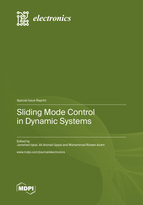Sliding Mode Control in Dynamic Systems
A special issue of Electronics (ISSN 2079-9292). This special issue belongs to the section "Systems & Control Engineering".
Deadline for manuscript submissions: closed (15 April 2023) | Viewed by 23150
Special Issue Editors
Interests: mechatronics; robotics; control systems
Special Issues, Collections and Topics in MDPI journals
Interests: nonlinear control; sliding mode control; optimal control; control of distributed parameter systems
Special Issue Information
Dear Colleagues,
Due to its inherent robustness and finite time convergence, sliding mode control (SMC) is extensively used for the control of nonlinear uncertain systems. Apart from robustness against parametric variations and external disturbances, it also provides model order reduction. It has been employed in a large range of dynamic systems, including but not limited to electric drives, power converters, power systems, aircraft, autonomous vehicles, a wide range of mechanical systems, and industrial processes. The discontinuous control law in SMC is the reason for its robustness. However, it is also responsible for the so-called chattering problem. Most of the research in SMC is carried out to address the chattering phenomenon, which gives rise to higher-order SMC, adaptive SMC and chattering-free SMC. Another important research topic pertaining to SMC is the finite-time convergence of the error dynamics, which leads to the advent of finite-time convergent SMC (FTSMC). Contrary to conventional SMC, the sliding variable in FTSMC is nonlinear, which results in the finite-time convergence of the sliding mode.
Currently, SMC is being extensively used in power converters, electric drives, the control of underactuated systems, the control of energy conversion systems, and fault-tolerant control. The integration of machine learning techniques with SMC has caught the attention of many control engineers.
The objective of this Special Issue is to bring together an articulate set of papers that advance our understanding of the theory and practice behind SMC and its variants. The Special Issue is timely since recent years have witnessed the notable experimental realization of SMC-based control laws in applications of immense importance.
Both theoretical and applied avenues fall within the scope of the Special Issue, thus making it equally interesting for mathematicians, engineers and scientists. Please note that modern control techniques other than SMC or its variants are not included in the scope of the Special Issue. In addition to original research papers, comprehensive and systematic reviews listing current challenges and suggesting possible future research directions on the subject topic are also welcomed. It is anticipated that the wider dissemination of recent research trends in SMC and its variants will stimulate more exchanges and collaborations among the control community and contribute to further advancements from an applied perspective.
Dr. Jamshed Iqbal
Dr. Ali Arshad Uppal
Dr. Muhammad Rizwan Azam
Guest Editors
Manuscript Submission Information
Manuscripts should be submitted online at www.mdpi.com by registering and logging in to this website. Once you are registered, click here to go to the submission form. Manuscripts can be submitted until the deadline. All submissions that pass pre-check are peer-reviewed. Accepted papers will be published continuously in the journal (as soon as accepted) and will be listed together on the special issue website. Research articles, review articles as well as short communications are invited. For planned papers, a title and short abstract (about 100 words) can be sent to the Editorial Office for announcement on this website.
Submitted manuscripts should not have been published previously, nor be under consideration for publication elsewhere (except conference proceedings papers). All manuscripts are thoroughly refereed through a single-blind peer-review process. A guide for authors and other relevant information for submission of manuscripts is available on the Instructions for Authors page. Electronics is an international peer-reviewed open access semimonthly journal published by MDPI.
Please visit the Instructions for Authors page before submitting a manuscript. The Article Processing Charge (APC) for publication in this open access journal is 2400 CHF (Swiss Francs). Submitted papers should be well formatted and use good English. Authors may use MDPI's English editing service prior to publication or during author revisions.
Keywords
- sliding mode control—theory and practice
- higher-order sliding mode controllers
- sliding mode observers
- fixed-time nonlinear homogeneous sliding mode controller
- fast integral terminal sliding mode controller
- adaptive or neuro-adaptive global sliding mode controller
- role of SMC in industry 4.0 cyber-physical systems
- application of SMC in control of:
- robotic manipulators
- unmanned aerial vehicles (UAVs)
- biomedical systems
- power converters
- power system
- electric drives
- process control
- other dynamic systems








